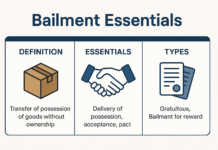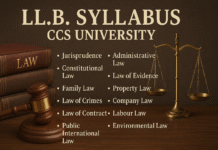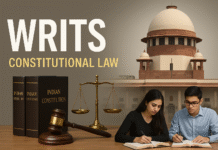| About | The magistrate of any Indian state or union territory can issue an order forbidding the gathering of four or more individuals in a specific place under this legislation. किसी भी भारतीय राज्य या केंद्र शासित प्रदेश का मजिस्ट्रेट इस कानून के तहत एक विशिष्ट स्थान पर चार या अधिक व्यक्तियों के इकट्ठा होने पर रोक लगाने का आदेश जारी कर सकता है। It is enforced in circumstances of immediate annoyance or suspected danger of an incident that might create problems or harm to human life or property. यह तत्काल झुंझलाहट या किसी घटना के संदिग्ध खतरे की परिस्थितियों में लागू किया जाता है जो मानव जीवन या संपत्ति को समस्या या नुकसान पहुंचा सकता है। This order might be issued against a specific person or the broader public. यह आदेश किसी विशिष्ट व्यक्ति या व्यापक जनता के खिलाफ जारी किया जा सकता है। |
| Features of Section 144 | It restricts the handling and transportation of any type of weapon inside the jurisdiction. यह अधिकार क्षेत्र के भीतर किसी भी प्रकार के हथियार के संचालन और परिवहन को प्रतिबंधित करता है। For such an act, the maximum penalty is three years in prison. इस तरह के कृत्य के लिए अधिकतम सजा तीन साल की जेल है। There will be no public movement and all educational institutions will be shuttered, according to the order issued under this provision. इस प्रावधान के तहत जारी आदेश के अनुसार कोई भी सार्वजनिक आंदोलन नहीं होगा और सभी शैक्षणिक संस्थान बंद रहेंगे। Furthermore, throughout the period in which this order is in effect, no public meetings or rallies will be permitted. इसके अलावा, इस आदेश के प्रभावी होने की अवधि के दौरान, किसी भी सार्वजनिक सभा या रैलियों की अनुमति नहीं दी जाएगी। Obstructing law enforcement agents from disbanding an unlawful assembly is a criminal offence. कानून प्रवर्तन एजेंटों को गैरकानूनी सभा को भंग करने से रोकना एक आपराधिक अपराध है। It also gives authorities the right to restrict internet access in the region. यह अधिकारियों को क्षेत्र में इंटरनेट के उपयोग को प्रतिबंधित करने का अधिकार भी देता है। Section 144’s ultimate goal is to ensure peace and order in regions where conflict might erupt and disturb daily life. धारा 144 का अंतिम लक्ष्य उन क्षेत्रों में शांति और व्यवस्था सुनिश्चित करना है जहां संघर्ष भड़क सकता है और दैनिक जीवन को परेशान कर सकता है। |
| Duration of Section 144 Order | No order issued under this provision may be in effect for more than two months. The state government might opt to prolong the validity for two additional months at its discretion, with a maximum validity of six months. Section 144 imposed can be revoked after the situation returns to normal. |
| Difference between S. 144 and Curfew | Section 144 restricts gatherings of four or more persons in the affected area, while people are required to stay indoors for a specific duration during curfew. The government has also placed a blanket ban on traffic. Markets, schools, universities, and workplaces are all shuttered during the curfew, with only vital services allowed to operate with advance warning. |
| Criticism | It’s overly broad, and the section’s wording are broad enough to grant a magistrate total power that may be used unjustifiably. A revision application to the magistrate himself is the first recourse against such an order. Infringement of Rights: If a person’s basic rights are violated, he or she can file a writ petition with the High Court. However, there are concerns that the rights may have already been violated before the High Court intervenes. Imposing Prohibition on a Big Region Isn’t Justifiable: Imposing prohibitory orders across a large area isn’t justifiable since security situations change from place to place and can’t be addressed in the same way. Prohibitory orders over a very large area were ordered in all of Uttar Pradesh during the protests against the Citizenship (Amendment) Bill. |
| Court’s Ruling on Sec. 144 | The Supreme Court ruled in the Dr Ram Manohar Lohiya case in 1967 that “no democracy can survive if ‘public order’ is freely permitted to be disrupted by a part of the citizenry.” Madhu Limaye vs. Sub-Divisional Magistrate (Madhu Limaye vs. Sub-Divisional Magistrate), 1970: The power of a magistrate under Section 144 “is not an ordinary power emanating from administration, but a power utilised in a judicial way and which can survive further judicial examination,” according to a seven-judge Bench led by then Chief Justice of India M Hidayatullah. The court, on the other hand, maintained the law’s validity, stating that the limits imposed by Section 144 are protected by Article 19(2) of the Constitution’s “reasonable restrictions” to basic rights. The fact that the “law may be misused” isn’t enough for the Court to overturn it. The government was chastised by the Supreme Court in 2012 for invoking Section 144 on a sleeping crowd in Ramlila Maidan. The court ruled that such a clause may only be applied in extreme cases to maintain public order. The provision’s effectiveness is to instantly avoid any negative occurrence. As a result, the emergency must be sudden, and the repercussions must be severe enough. The Supreme Court further ruled that such a clause cannot be used to limit individuals’ basic right to peacefully assemble, and that it cannot be used as a “tool” to “block the lawful expression of opinion or grievance or the exercise of any democratic rights.” |
- Home
- Education
- Laws
- 1st Semester
- Constitutional Law of India – 1
- Contract
- Jurisprudence
- Law of Crimes
- Law of Torts
- 2nd Semester
- Constitutional Law of India – 2
- Contract 2
- Family Law (Hindu Law)
- Jurisprudence 2
- Law of Taxtion
- 3rd Semester
- 4th Semester
- Company Law
- Environmental Law
- Labour and Industrial Law
- 5th Semester
- Civil Procedure Code And Limitation Act
- Law of Crimes – II
- Case Laws
- Drafting
- THE CODE OF CRIMINAL PROCEDURE, 1973
- General Knowledge
- Health
- History
- Current Affairs
Welcome!Log into your account















